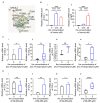Excess Heme Promotes the Migration and Infiltration of Macrophages in Endometrial Hyperplasia Complicated with Abnormal Uterine Bleeding
- PMID: 35740976
- PMCID: PMC9221196
- DOI: 10.3390/biom12060849
Excess Heme Promotes the Migration and Infiltration of Macrophages in Endometrial Hyperplasia Complicated with Abnormal Uterine Bleeding
Abstract
In patients, endometrial hyperplasia (EH) is often accompanied by abnormal uterine bleeding (AUB), which is prone to release large amounts of heme. However, the role of excess heme in the migration and infiltration of immune cells in EH complicated by AUB remains unknown. In this study, 45 patients with AUB were divided into three groups: a proliferative phase group (n = 15), a secretory phase group (n = 15) and EH (n = 15). We observed that immune cell subpopulations were significantly different among the three groups, as demonstrated by flow cytometry analysis. Of note, there was a higher infiltration of total immune cells and macrophages in the endometrium of patients with EH. Heme up-regulated the expression of heme oxygenase-1 (HO-1) and nuclear factor erythroid-2-related factor 2 (Nrf2) in endometrial epithelial cells (EECs) in vitro, as well as chemokine (e.g., CCL2, CCL3, CCL5, CXCL8) levels. Additionally, stimulation with heme led to the increased recruitment of THP-1 cells in an indirect EEC-THP-1 co-culture unit. These data suggest that sustained and excessive heme in patients with AUB may recruit macrophages by increasing the levels of several chemokines, contributing to the accumulation and infiltration of macrophages in the endometrium of EH patients, and the key molecules of heme metabolism, HO-1 and Nrf2, are also involved in this regulatory process.
Keywords: HO-1; abnormal uterine bleeding; endometrial hyperplasia; heme; immune cells; macrophages.
Conflict of interest statement
The authors declare no financial or commercial conflict of interest.
Figures








Similar articles
-
Endometrial cancer and hyperplasia rate in women before menopause with abnormal uterine bleeding undergoing endometrial sampling.Przegl Lek. 2017;74(4):139-43.. Przegl Lek. 2017. PMID: 29696944
-
Prediction of Endometrial Hyperplasia and Cancer among Premenopausal Women with Abnormal Uterine Bleeding.Biomed Res Int. 2019 Mar 18;2019:8598152. doi: 10.1155/2019/8598152. eCollection 2019. Biomed Res Int. 2019. PMID: 31011581 Free PMC article.
-
Efficacy of the levonorgestrel intrauterine system (LNG-IUS) in the prevention of the atypical endometrial hyperplasia and endometrial cancer: retrospective data from selected obese menopausal symptomatic women.Gynecol Endocrinol. 2013 Feb;29(2):156-9. doi: 10.3109/09513590.2012.730579. Epub 2012 Nov 7. Gynecol Endocrinol. 2013. PMID: 23134558
-
The role of decidual cells in uterine hemostasis, menstruation, inflammation, adverse pregnancy outcomes and abnormal uterine bleeding.Hum Reprod Update. 2016 Jun;22(4):497-515. doi: 10.1093/humupd/dmw004. Epub 2016 Feb 23. Hum Reprod Update. 2016. PMID: 26912000 Free PMC article. Review.
-
Management of pre-, peri-, and post-menopausal abnormal uterine bleeding: When to perform endometrial sampling?Int J Gynaecol Obstet. 2022 Aug;158(2):252-259. doi: 10.1002/ijgo.13988. Epub 2021 Oct 31. Int J Gynaecol Obstet. 2022. PMID: 34669187 Review.
Cited by
-
Active Estrogen-Succinate Metabolism Promotes Heme Accumulation and Increases the Proliferative and Invasive Potential of Endometrial Cancer Cells.Biomolecules. 2023 Jul 10;13(7):1097. doi: 10.3390/biom13071097. Biomolecules. 2023. PMID: 37509133 Free PMC article.
-
The regulation of intestinal flora on host's genes may play an essential role in the development of endometrial hyperplastic processes in yang deficiency individuals.Int J Clin Exp Pathol. 2024 Apr 15;17(4):121-136. doi: 10.62347/HBKG3920. eCollection 2024. Int J Clin Exp Pathol. 2024. PMID: 38716350 Free PMC article.
-
SHP2-Triggered Endothelial Cell Activation Fuels Estradiol-Independent Endometrial Sterile Inflammation.Adv Sci (Weinh). 2024 Nov;11(41):e2403038. doi: 10.1002/advs.202403038. Epub 2024 Sep 5. Adv Sci (Weinh). 2024. PMID: 39234819 Free PMC article.
-
SIRT5 participates in the suppressive tumor immune microenvironment of EGFR-mutant LUAD by regulating the succinylation of ACAT1.Heliyon. 2024 Oct 22;10(21):e39743. doi: 10.1016/j.heliyon.2024.e39743. eCollection 2024 Nov 15. Heliyon. 2024. PMID: 39524872 Free PMC article.
-
Free heme exacerbates colonic injury induced by anti-cancer therapy.Front Immunol. 2023 Jun 5;14:1184105. doi: 10.3389/fimmu.2023.1184105. eCollection 2023. Front Immunol. 2023. PMID: 37342339 Free PMC article.
References
-
- Ottnad E., Parthasarathy S., Sambrano G.R., Ramprasad M.P., Quehenberger O., Kondratenko N., Green S., Steinberg D. A macrophage receptor for oxidized low density lipoprotein distinct from the receptor for acetyl low density lipoprotein: Partial purification and role in recognition of oxidatively damaged cells. Proc. Natl. Acad. Sci. USA. 1995;92:1391–1395. doi: 10.1073/pnas.92.5.1391. - DOI - PMC - PubMed
-
- Acmaz G., Aksoy H., Unal D., Ozyurt S., Cingillioglu B., Aksoy U., Muderris I. Are neutrophil/lymphocyte and platelet/lymphocyte ratios associated with endometrial precancerous and cancerous lesions in patients with abnormal uterine bleeding? Asian Pac. J. Cancer Prev. 2014;15:1689–1692. doi: 10.7314/APJCP.2014.15.4.1689. - DOI - PubMed
Publication types
MeSH terms
Substances
LinkOut - more resources
Full Text Sources
Medical

